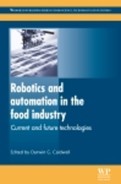Table of Contents
Woodhead Publishing Series in Food Science, Technology and Nutrition
Part I: Introduction, key technologies and significant areas of development
Chapter 1: Automatic process control for the food industry: an introduction
1.2 Process control systems and structure in the food industry
1.3 Process control methods in the food industry
Chapter 2: Robotics in the food industry: an introduction
2.2 Current manufacturing procedures
2.3 Automation in the food sector
2.4 Specifications for a food sector robot
Chapter 3: Sensors for automated food process control: an introduction
3.2 Special considerations for food instrumentation
3.5 Applications of sensors in automated food process control
Chapter 4: Machine vision in the food industry
4.2 Machine vision: principles and methods
4.3 Applications and case studies
4.4 Recent advances in the application of vision in the food industry
4.5 Appraisal of the need for special hardware for food inspection applications
4.6 Conclusion and future trends
4.8 Sources of further information and advice
5.2 Optical sensing and spectroscopic techniques
5.3 Applications in the food industry
6.1 Introduction to Supervisory Control and Data Acquisition
6.3 SCADA standards and applications
6.5 Laboratory study: implementation of SCADA
Chapter 7: Gripper technologies for food industry robots
7.2 Gripper challenges in food process automation
7.4 Pinching and enclosing grippers
7.5 Penetrating (needle) grippers
7.7 Surface effect (freeze) grippers
7.8 Selection of the appropriate gripping technology
7.9 Future trends: from laboratory to industry
Chapter 8: Wireless sensor networks (WSNs) in the agricultural and food industries
8.2 Current state of development of WSNs
8.3 WSN applications in agriculture and food production
8.4 Future trends in WSN technology in agriculture and food production
Chapter 9: Intelligent quality control systems in food processing based on fuzzy logic
9.2 Principles of intelligent control systems using fuzzy logic
9.3 Current applications in the food industry
9.4 Advances in research and future trends
10.2 The basic dynamical model
10.3 Modelling issues: population balance modelling in food processes
10.4 Monitoring issues: tuning of observer-based estimators
10.5 Design of PID controllers for fed-batch processes
Part II: Robotics and automation in particular unit operations and industry sectors
Chapter 11: Automation and robotics for bulk sorting in the food industry
11.4 Recent advances in technology
11.8 Sources of further information and advice
Chapter 12: Automatic control of food chilling and freezing
12.1 Introduction: key drivers and challenges for automatic control of food chilling and freezing
12.2 Automation in refrigerated food retail display
12.3 Automation of refrigeration and freezing operations in food catering
12.4 Automation in refrigerated food transport systems
12.5 Automation in food chilling and freezing systems
12.6 Automation in food cold storage systems
12.7 Advances in research and future trends
12.8 Sources of further information and advice
Chapter 13: Robotics and automation in meat processing
13.2 Automation of carcass production processes before primary chilling
13.3 Automation of carcass separation processes after primary chilling
13.6 Sources of further information and advice
Chapter 14: Robotics and automation in the poultry industry: current technology and future trends
14.2 Robotics and automation in live hanging and first processing of poultry
14.3 Robotics and automation in second processing of poultry
14.4 Robotics and automation in bulk packing and shipping of poultry meat
Chapter 15: Robotics and automation in seafood processing
15.2 Technologies for robotics and automation in the seafood industry
15.4 Automation in other unit operations in fish processing
15.6 Sources of further information and advice
Chapter 16: Robotics and automation in the fresh produce industry
16.2 Machine vision system as a key technology
16.3 Vegetable preprocessing and grading systems
16.4 Information flow for food traceability and farming guidance
Chapter 17: Robotics and automation for packaging in the confectionery industry
17.2 The confectionery market and its business requirements
17.3 Reconfigurable mechanism technology
17.4 Case study of a reconfigurable system for carton folding
Chapter 18: Automatic control of batch thermal processing of canned foods
18.2 On-line control strategies
18.3 Validation of computer-based control systems
18.4 Industrial automation of batch retorts
18.5 Advances in research and future trends
19.2 Definition of sustainability and links with the food industry
19.3 Automation and sustainability in food manufacturing
19.4 Tools for automated sustainable design and operation in food engineering
19.5 Advanced tools and methods for sustainable food engineering with potential applications
19.6 Software technologies for automated sustainable design
19.7 Conclusions and future trends
